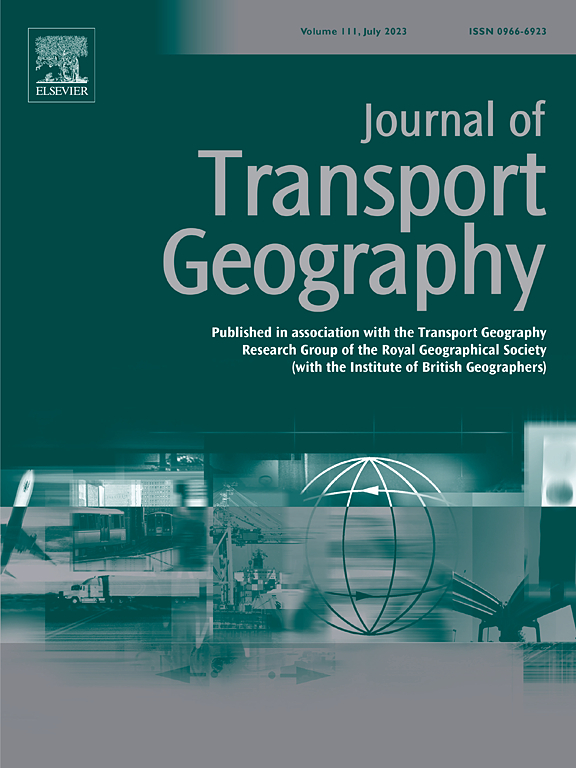美国农村地区的旅行负担:未满足的需求和旅行成本
IF 6.3
2区 工程技术
Q1 ECONOMICS
引用次数: 0
摘要
交通可达性,即到达有价值目的地的难易程度,是决定一个人能否满足其基本需求的关键因素。缺乏交通可达性会造成旅行负担,如高昂的交通费用或无法满足的需求,并对幸福感产生不利影响。先前的研究表明,旅行负担与交通选择(如公共交通)、目的地距离以及个人资源(包括收入和个人车辆)之间存在反比关系。虽然人们知道农村与城市的出行行为有所不同,但对农村社区出行负担的性质却知之甚少。本研究利用 2017 年全国家庭旅行调查,量化并比较了美国农村与非农村社区的旅行负担。在每种情况下,我们都量化并比较了 i) 旅行负担的程度;ii) 谁会经历旅行负担;iii) 与旅行负担相关的个人和环境因素。我们发现,农村居民的旅行负担率更高。与生活在非农村地区的人相比,生活在农村地区的人更有可能报告由于缺乏交通选择而造成的旅行成本负担和旅行需求得不到满足的情况,而对于没有汽车的人来说,这些差异会更加严重。与城市相比,分散的农村地区具有独特性,因为它们同时表现出较高的经济负担率和未满足需求率。在农村地区,与居住较为分散的地区相比,居住在小城镇的人的经济负担和未满足需求的情况较少,这表明,即使服务和机会稍有集中,也可能有助于获得更多的服务和机会。总之,我们的研究结果突出表明,有必要针对农村社区的具体需求和策略开展研究,以解决出行负担问题。本文章由计算机程序翻译,如有差异,请以英文原文为准。
Rural travel burdens in the United States: Unmet need and travel costs
Transportation accessibility, or the ease of reaching valued destinations, is a critical determinant of a person's ability to satisfy their essential needs. A lack of accessibility can result in travel burdens such as high transportation costs or unmet needs and adversely affect well-being. Prior research establishes the inverse relationship between travel burdens and access to transportation options such as public transit and proximity to destinations as well as a person's resources, including their income and access to a personal vehicle. Although travel behavior is understood to differ across rural versus urban contexts, little is known about the nature of travel burdens in rural communities. Using the 2017 National Household Travel Survey, this study quantifies and compares travel burdens in rural versus nonrural communities in the United States. In each context, we quantify and compare i) the magnitude of travel burdens, ii) who experiences travel burdens, and iii) the individual and environmental factors that are associated with travel burdens. We find higher rates of burdensome travel outcomes among rural residents. People who live in rural areas are more likely to report burdensome travel costs and unmet travel needs due to a lack of transportation options compared to people living in nonrural areas, and these differences are exacerbated for people without car access. Dispersed rural contexts are unique in that they exhibit a combination of higher rates of financial burden and unmet need relative to urban contexts. Within rural areas, financial burdens and unmet need are less prevalent for those who live in a small town when compared with those living in more dispersed areas, which suggests that even a small concentration of services and opportunities may facilitate greater access. Collectively, our results highlight the need for research that attends to context-specific needs and strategies to address travel burdens in rural communities.
求助全文
通过发布文献求助,成功后即可免费获取论文全文。
去求助
来源期刊

Journal of Transport Geography
Multiple-
CiteScore
11.50
自引率
11.50%
发文量
197
期刊介绍:
A major resurgence has occurred in transport geography in the wake of political and policy changes, huge transport infrastructure projects and responses to urban traffic congestion. The Journal of Transport Geography provides a central focus for developments in this rapidly expanding sub-discipline.
 求助内容:
求助内容: 应助结果提醒方式:
应助结果提醒方式:


